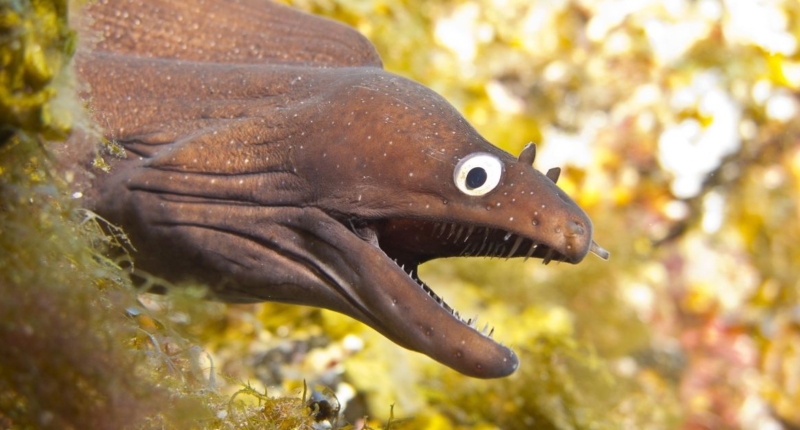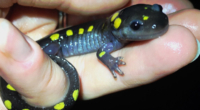Researchers have found that some animals have evolved their own toxins as a defense mechanism against predators, making them poisonous without consuming toxic substances themselves. For example, the Southern and Northern Corroboree frogs make their own poison, and the garden tiger moth uses neurotoxic alkaloids acquired from plants. Similarly, the mottled Fowler’s toad secretes a noxious substance called bufotoxin from the warts on its back to deter predators. The toxic gray side-gilled sea slug also has a potent poison called tetrodotoxin, found in its eggs, larvae, and body, which can be lethal to humans. Meanwhile, research has suggested that early Polynesian voyages of discovery were driven in part by the search for safe food sources due to the large-scale circulation changes that resulted in ciguatera poisoning events.
30 Exceptionally Poisonous Animals
There are some animals that should not be consumed under any circumstances. Some animals are venomous and produce their toxins, which can paralyze or kill when delivered through fangs or a stinger. However, there is another group of poisonous creatures that are deadly if they’re consumed or even touched. Though some of these species, like the poison dart frog, are well-known, there are a host of unexpected poisonous animals. Here are some unusual creatures that you should never eat.
Hooded Pitohui
Pitohuis are a bird species found in New Guinea. Though they appear to be harmless, in several species, the skin and feathers contain neurotoxins similar to those found in poison dart frogs. Hooded pitohui (Pitohui dichrous) contains batrachotoxins that can disrupt the nervous system, causing paralysis or cardiac arrest in sufficient amounts. No fatalities from hooded pitohui contact have been recorded, but local hunters have long avoided the birds. Scientists aren’t sure why pitohuis are poisonous, but they believe the toxins may deter predators or defend against parasites. A study found that the batrachotoxins deterred and killed lice. Pitohuis don’t generate their poisons themselves, but instead accumulate toxins from their diet. The source is likely beetles from the genus Choresine, which are just 0.23 inches (6 millimeters) long and have iridescent blue-green coloring. They’re eaten by pitohuis and are referred to by locals as “nanisani,” which also describes the tingling and numbing sensation caused by touching pitohuis.
Brush Bronzewing
The brush bronzewing (Phaps elegans) is a bird species native to Australia. It appears to be just another bird, but it has a trick up its sleeve: it can produce a toxin that’s deadly to humans. The bird’s primary food source is the toxic seeds of the emu bush, which it ingests without ill effect. The seeds contain a toxin called cycasin, which is usually harmful to mammals. The brush bronzewing, on the other hand, can convert cycasin into a toxin that causes illness and death in humans. Symptoms of poisoning include vomiting, diarrhea, and abdominal pain, and in severe cases, coma and death. There have been no reported fatalities from brush bronzewing poisoning, but it’s best not to take any chances.
Beware of These Poisonous Animals: From Birds to Snakes
Animals can be dangerous in a variety of ways, and while some are venomous and can inject toxins, others are poisonous and can harm you when eaten or touched. Here are some animals that you should be wary of.
Brush Bronzewing
The brush bronzewing (Phaps elegans) is an Australian pigeon species with a beautiful iridescent splash of color on its wings. However, the bird’s flesh is toxic due to its consumption of the poisonous seeds of Gastrolobium plants. Other Australian species, such as the brush-tailed possum and boodie, have also been known to eat these seeds and poison their predators or scavengers.
Carolina Parakeet
The Carolina parakeet (Conuropsis carolinensis) is a bird that once lived in the eastern US, Midwest, and part of the Great Plains but went extinct in 1939 due to human hunting. Interestingly, the bird may have been poisonous because it ate cockleburs, a native thorny plant that is toxic to many animals. Dogs that ate the parakeets died, according to naturalist James Audubon. The parakeet’s diet may have protected the bird from predators.
Pacific Newts
The four newts of the genus Taricha are small but deadly. These species found along the Pacific coast of North America contain tetrodotoxin, a neurotoxin that blocks signals between nerve cells. This leads to paralysis of the diaphragm muscles, halting breathing and leading to death unless the individual seeks immediate medical intervention.
One case of a person dying after consuming a rough-skinned newt was reported in 1981. A 29-year-old man swallowed the newt on a dare and soon began to complain of numbness and tingling. Within two hours, his breathing stopped, and he died due to the newt’s neurotoxin.
Garter Snake
Garter snakes are found throughout North America and are harmless to humans, but there’s a twist. Some garter snakes, such as the common garter snake (Thamnophis sirtalis), have a diet of rough-skinned newts and accumulate the toxin in their bodies. These snakes are poisonous, and while the toxin isn’t deadly to humans, it can cause symptoms such as numbness, tingling, and muscle weakness.
In conclusion, while some animals may seem harmless or even beautiful, their toxicity levels should be taken seriously. It’s essential to understand what you’re dealing with when encountering these animals to prevent any mishaps.
Unusual Poisonous Animals
There are some animals that can be deadly when consumed or touched because of their toxicity. This toxicity can be self-generated or accumulated from their prey, making them dangerous to other animals or even humans. Below are some of the most unusual poisonous animals that one should be aware of.
Brush Bronzewing
Brush Bronzewing (Phaps elegans) is a species of Australian pigeon with a beautiful iridescent color on its wings. Reports indicate that animals die after consuming these birds, and scientists later found out that Brush Bronzewings’ flesh is toxic. The bird feeds on poisonous seeds of Gastrolobium plants, and this helps it accumulate toxins in its flesh. Other native Australian species, such as the brush-tailed possum (Trichosurus vulpecula) and boodie (Bettongia lesueur), both marsupials, have also been known to eat Gastrolobium seeds and poison their predators or scavengers.
Carolina Parakeet
The Carolina parakeet (Conuropsis carolinensis) was one of only three parrot species native to what is now the United States. This brightly colored bird used to live in the eastern U.S., Midwest, and part of the Great Plains but went extinct in 1939 due to human hunting. Interestingly, this bird may have been poisonous. The bird ate cockleburs (Xanthium strumarium), a thorny native plant that is itself toxic to many animals. The 19th-century naturalist James Audubon reported that dogs that ate the parakeets died. As with the brush bronzewing, the Carolina parakeet’s diet may have protected the bird from predators.
Pacific Newts
Pacific newts of the genus Taricha – the rough-skinned newt (Taricha granulosa), the red-bellied newt (Taricha rivularis), the Sierra newt (Taricha sierrae) and the California newt (Taricha torosa) – contain tetrodotoxin, a neurotoxin that blocks signals between nerve cells. This leads to the paralysis of the muscles of the diaphragm, halting breathing and leading to death unless the individual seeks immediate medical intervention, such as being put on a ventilator. There is at least one case of a person dying after consuming a rough-skinned newt.
Garter Snake
Garter snakes (Thamnophis sirtalis) are resistant to tetrodotoxin and can feed upon Pacific newts without dying. According to a 2004 study, toxins from the newts remain in the garter snake liver for at least a month. Three weeks after eating just one newt, the snakes had enough tetrodotoxin in their livers to kill any bird unlucky enough to try eating them, the research found.
Milkweed Butterflies
Milkweed butterflies in the subfamily Danainae carry toxins, particularly in the caterpillar stage, because these insects feed upon the toxic milkweed plant. These toxins, called cardiac glycosides, can cause nausea, vomiting, vision changes, and fatal disruptions to the heart rhythm, among other symptoms, in large enough quantities.
Barracudas
The barracuda fish isn’t toxic on its own, but it can cause poisoning when consumed. If barracudas consume fish that have been chowing down on the dinoflagellate Gambierdiscus toxicus, a single-celled marine organism, the dinoflagellate’s toxins can accumulate in the barracudas’ flesh. People who eat contaminated barracuda flesh contract a disease called ciguatera, marked by diarrhea, cramps, vomiting,
Unusual Poisonous Animals
There are some animals in the world that carry toxins in their flesh that can be dangerous to humans and other animals. From sharks to butterflies, here are some of the most unusual poisonous creatures in the animal kingdom.
Greenland Shark
The Greenland shark is the longest-living vertebrate species in the world, able to survive for hundreds of years. This slow-moving giant inhabits the deep, cold waters of the Arctic and North Atlantic and grows up to 24 feet (7.3 meters) long, weighing up to 2,645 pounds (1,200 kilograms).
To survive in very cold temperatures and high water pressure, the Greenland shark uses a compound called trimethylamine oxide (TMAO) to stabilize its proteins. When digested, TMAO breaks down into trimethylamine (TMA), which is a neurotoxin that causes intoxicating effects similar to those of alcohol. People who have eaten the shark’s meat are sometimes referred to as “shark drunk” by Greenland natives.
Milkweed Butterflies
Milkweed butterflies, including the monarch butterfly, carry toxins from the milkweed plant they feed on, particularly in the caterpillar stage. These toxins, called cardiac glycosides, can cause nausea, vomiting, vision changes, and fatal disruptions to the heart rhythm if consumed in large quantities.
Barracudas
Barracudas aren’t toxic on their own, but if they consume fish that have been eating the dinoflagellate Gambierdiscus toxicus, the dinoflagellate’s toxins can accumulate in the barracuda’s flesh. People who eat contaminated barracuda flesh can contract a disease called ciguatera, marked by diarrhea, cramps, vomiting, heart arrhythmias, and pain.
Garter Snakes
Garter snakes have a mild venom and small fangs that are not dangerous to humans. However, they are resistant to tetrodotoxin, which allows them to feed on Pacific newts without dying. After a Pacific newt meal, toxins from the newts remain in the garter snake liver for at least a month. The snakes then have enough tetrodotoxin in their livers to kill any bird unlucky enough to try eating them.
Blue-Capped Ifrit
The blue-capped ifrit is a colorful rainforest bird endemic to New Guinea. Eating the bird causes tingling and numbness in the mouth, similar to biting into a hot chili pepper. The culprit is the same batrachotoxin that makes pitohuis toxic, most likely from the same dietary source. The toxins are most prevalent on the legs, belly, and breast feathers, leading to speculation that they might rub off on the birds’ eggs, helping protect them from predators.
Quail
The meat of the common quail can be toxic, causing a disorder called coturnism. Symptoms include muscle pain, nausea, and vomiting, caused by rhabdomyolysis, or the breakdown of muscle cells. Coturnism may even get a mention in the Hebrew Bible, with the Book of Numbers describing a mass poisoning of Israelites after a feast of quail.
These unusual poisonous animals serve as a reminder that there is always more to learn about the animal kingdom and its many fascinating adaptations.
Unusual Poisonous Animals
While some animals use their bright colors or patterns to attract mates or scare off predators, others have evolved to advertise their toxicity. These creatures pack a punch with their venom or poison, making them some of the most unusual poisonous animals in the world.
Quail
While the common quail may be unassuming, it can also be deadly. During quail migration season, some people have suffered from coturnism after consuming quail meat. Symptoms include muscle pain, nausea, and vomiting caused by rhabdomyolysis. Scientists suspect that quail are feeding on a particular toxic plant during migration season, possibly hemlock.
Cinnabar Moth
Found in Europe and Asia, the cinnabar moth has wings decorated with bright-red patches that warn predators not to eat them. Moth larvae feed on ragwort plants and incorporate bitter alkaloid compounds from the plants into their tissues, making them unpalatable to most predators.
Shrikethrush
The Arafura shrikethrush, found in forests in New Guinea and Australia, may contain batrachotoxins in their bodies. The concentration of these toxins likely depends on their diet. A 2000 study found that one specimen of little shrikethrush tested positive for trace amounts of batrachotoxins, while the other did not.
Palythoa
Palythoa is a type of cnidarian that looks like a frilly undersea mushroom, with rings of tentacles surrounding a disc-like mouth. While toxins are standard among cnidarians, Palythoa species are known for their particularly nasty poison, palytoxin. This toxin breaks down red blood cells, causes heart arrhythmias and muscle spasms, and can be fatal in small doses. There is no antidote for palytoxin.
Greenland Shark
The longest-living vertebrate species, the Greenland shark can survive for hundreds of years. These slow-moving giants live in the deep, cold waters of the Arctic and North Atlantic. They stabilize their proteins with a compound called trimethylamine oxide (TMAO) to survive in very cold temperatures and under high water pressure. When digested, TMAO breaks down into trimethylamine (TMA), a neurotoxin that causes intoxicating effects similar to those of alcohol. Humans and sled dogs who have eaten the shark’s meat are sometimes referred to as “shark drunk” by Greenland natives.
Other Unusual Poisonous Animals
Other animals that made the list of unusual poisonous animals include Garter Snakes, Milkweed Butterflies, Barracudas, and Blue-capped Ifrits. Garter snakes have a mild venom and are resistant to tetrodotoxin, allowing them to feed on Pacific newts without dying. Milkweed butterflies feed on toxic milkweed plants and carry toxins called cardiac glycosides. Barracudas can become toxic if they consume fish that have been eating the dinoflagellate Gambierdiscus toxicus. Blue-capped Ifrits incorporate batrachotoxins from Choresine beetles, making them unpalatable to most predators.
Several marine animals, including cnidarians, octopuses, and cuttlefish, produce potent toxins that can cause serious illness or even death in humans. Some marine creatures use these toxins to ward off predators, while others use them for hunting. Handling marine animals containing toxins can be dangerous and even fatal, and some toxins can be airborne, making inhalation a risk.
Palythoa
Palythoa, a genus of cnidarian, is known for its highly toxic poison, palytoxin, which is known to break down red blood cells and cause heart arrhythmias and muscle spasms. Palythoa toxica, a species native to Hawaii, is called “limu-make-o-Hana” or “seaweed of death from Hana” in the indigenous Hawaiian language. The toxin is so potent that aquarium hobbyists have reported symptoms of poisoning after handling the coral, and even inhaling coral dust or aerosolized coral during cleaning can cause respiratory problems.
Blue-ringed octopus
Four species of octopus found in the Pacific and Indian oceans, including the greater blue-ringed octopus, southern blue-ringed octopus, blue-lined octopus, and blue-ringed octopus, produce tetrodotoxin, a deadly neurotoxin. Just handling these octopuses can be deadly, with even a milligram of the tetrodotoxin in an octopus’s saliva able to kill a human. The toxin is found throughout the octopus’s tissues, not just in venom glands, making it poisonous as well as toxic. Bites are rare, with only three confirmed deaths reported, but the tetrodotoxin content makes the octopus an unappetizing meal for predators.
Flamboyant cuttlefish
The flamboyant cuttlefish, found in the Indo-Pacific region, is the only cuttlefish species known to contain a toxin. Researchers have found tetrodotoxin in the cuttlefish’s tissues, but it is still unclear whether the toxin is potent enough to deter predators. The cuttlefish’s flame-like coloration and frilly body shape provide an eye-catching warning against consumption, but many animals still eat the cuttlefish with no apparent ill effects.
Colorado River toad
The Colorado River toad, also known as the Sonoran Desert toad, produces a potent toxin called bufotenin, which is found in its skin glands. The toxin can cause hallucinations, respiratory problems, seizures, and even death in humans. Some people seek out the toad for its psychoactive properties, but handling the toad or ingesting its venom can be extremely dangerous. The toad is also a popular food source for some animals, including dogs, who can become sick or die from consuming the venom.
Toxic Creatures You Don’t Want to Meet
Some creatures, in their efforts to protect themselves, have evolved toxins that can be deadly to predators, humans, and other animals. Let’s take a look at some of the animals that have toxins and why they have them.
Colorado River Toad
The Colorado River toad produces a hallucinogen called 5-methoxy-N,N-dimethyltryptamine (5-MeO-DMT). This toad is found in the southwestern United States and northern Mexico. While 5-MeO-DMT can be toxic when ingested, especially to the types of predators that normally might eat the toads, such as coyotes, it is also a potent psychedelic that researchers are now studying as a potential mental health treatment. However, this interest could be bad for the toad, as illegal collection of their toxins might threaten the species.
Blister Beetles
Blister beetles are known for secreting cantharidin, a toxin that causes blistering. While cantharidin can be beneficial, too, such as for wart removal treatments, it can be fatal if ingested. Blister beetles present a deadly threat to livestock. When they are inadvertently crushed during harvest and processing, they can end up in the hay fed to horses, cattle, and sheep. In these animals, cantharidin poisoning yields symptoms such as diarrhea and bloody urine and can be fatal.
Hawksbill Sea Turtle
The hawksbill sea turtle is a critically endangered species that can be found in tropical and subtropical oceans. Hawksbill sea turtles consume large amounts of sponges that contain toxins harmful to other marine life. However, hawksbill sea turtles are immune to these toxins, and they store the toxins in their tissues. If someone were to eat a hawksbill sea turtle, the toxins could be harmful or even deadly.
Blue-Ringed Octopus
The blue-ringed octopus is a small cephalopod found in the Pacific and Indian oceans. These cephalopods contain the deadly neurotoxin tetrodotoxin, making them one of the most dangerous marine animals. Just handling a blue-ringed octopus can be deadly. Even a milligram of the tetrodotoxin in an octopus’ saliva can kill a human.
Flamboyant Cuttlefish
The flamboyant cuttlefish is the only cuttlefish species known to contain a toxin. Researchers have found tetrodotoxin in the cuttlefish’s tissues. However, there is still debate over whether the cuttlefish are toxic enough to deter predators with this tetrodotoxin, as plenty of animals do eat the cuttlefish with no sign of adverse effects.
Palythoa
Palythoa is a genus of cnidarian, the soft-bodied animals that include corals and jellyfish. Palythoa species are known for their particularly nasty poison, palytoxin. Palytoxin breaks down red blood cells, causes heart arrhythmias and muscle spasms, and can be fatal in small doses. Aquarium hobbyists have reported poisoning symptoms from handling suspected Palythoa polyps. Even inhaling coral dusts or aerosolized coral during aquarium cleaning can cause respiratory symptoms.
Conclusion
These creatures remind us that it is important to be cautious around animals, even those that are seemingly harmless. It’s important to respect these animals and their habitats to ensure that they can continue to thrive in the world.
Toxic Creatures Found in Nature
Nature is home to many creatures, some of which possess deadly toxins. Here are some of the most interesting ones:
Colorado River Toad
The Colorado River toad, also known as the Sonoran desert toad (Incilius alvarius), produces a hallucinogenic toxin called 5-methoxy-N,N-dimethyltryptamine (5-MeO-DMT) that can be toxic when ingested. A mouthful of toad can kill a typical pet dog, according to the Arizona-Sonora Desert Museum. However, when dried and smoked, 5-MeO-DMT is a potent psychedelic that researchers are now studying as a potential mental health treatment.
Blister Beetles
Blister beetles of the family Meloidae secrete a toxin called cantharidin that causes blistering. Cantharidin is also used in wart-removal treatments. However, blister beetles present a deadly threat to livestock. They are found in alfalfa fields, and when they are crushed during harvest and processing, they can end up in the hay fed to horses, cattle, and sheep. In these animals, cantharidin poisoning yields symptoms such as diarrhea and bloody urine and can be fatal.
Hawksbill Sea Turtle
The Hawksbill sea turtle (Eretmochelys imbricata) is an endangered species that feeds on sponges, including toxic ones. The toxins can accumulate in the turtles’ fat stores, making their meat poisonous. In 2010, four children and two adults died, and 95 other adults fell ill in Micronesia after consuming contaminated turtle meat.
Arrow-Poison Beetle
The Diamphidia nigroornata, also known as the Bushman arrow-poison beetle, secretes a toxin that does not harm humans when ingested but can break down blood cells when injected into the bloodstream. The San people of southern Africa use the extract to poison their arrows.
Puffer Fish
Some species of puffer fish contain the deadly neurotoxin tetrodotoxin, mainly in the liver and sex organs. Trained chefs can prepare toxic puffer fish without poisoning diners, but mistakes in preparation can be deadly. According to research published in 2018, there were 106 cases of tetrodotoxin poisoning in China between 2003 and 2008, causing 16 deaths.
Battus Butterflies
Butterflies in the genus Battus, known colloquially as swallowtail butterflies, feed off pipevine plants in the genus Aristolochia, which are toxic to humans. However, Battus larvae have no problem eating the plants, incorporating their toxins so that they taste disgusting to predators.
Spur-Winged Goose
The spur-winged goose is a bird native to Africa that feeds on blister beetles, which contain cantharidin. The goose is unaffected by the toxin, but it incorporates the toxin into its own feathers, which predators avoid because of their bitter taste.
Nature is full of fascinating creatures that have developed unique ways to protect themselves from predators. While some of these animals may be toxic to humans, it’s important to remember that they play important roles in their ecosystems and should be respected and protected.
Unusual Poisonous Animals
This article sheds light on some of the most fascinating creatures in the animal kingdom that possess toxins harmful to humans and other animals. From birds to fish, let’s explore the world of poisonous animals.
Spur-winged goose
Spur-winged geese are waterfowl species native to sub-Saharan wetlands in Africa. Some populations of these geese are toxic due to the accumulation of cantharidin from blister beetles. Cantharidin makes the meat of the spur-winged goose highly unappetizing and may cause symptoms such as blistering of the mouth and throat, abdominal pain and cramping, and dehydration from cells leaking fluid.
Eurasian hoopoes
Eurasian hoopoes have a unique poison factory in their bodies. These birds have a gland over their tails called the uropygial gland, which typically produces oils that they use to preen their feathers. In Eurasian hoopoes, this gland is colonized by bacteria of the genus Enterococcus, which produce dimethyl sulfide, a highly odorous compound that can be hazardous in large doses.
Boxfish
Boxfish have striking polka-dot patterns and strange angular bodies that resemble cartoon characters. When threatened, these fish excrete a mucousy toxin that breaks down red blood cells and is deadly to potential predators. In aquariums, where the toxin can recirculate indefinitely, boxfish sometimes cause sudden death in their tankmates.
Moray eel
Moray eels are large predators that accumulate marine plankton toxins that cause ciguatera disease in their flesh. This accumulation of toxins can make moray eel potentially deadly to eat.
In conclusion, these animals have developed unique mechanisms to produce or acquire toxins that they use for self-defense, making them potentially dangerous to humans and other animals. While they are fascinating creatures, it is essential to be cautious and avoid coming into contact with them.
Unusual Poisonous Animals
Nature can be both fascinating and deadly. Some animals are toxic to those who consume them, while others can poison predators to make themselves unappetizing. Here are some unusual poisonous animals found around the world.
Spur-Winged Goose
The Spur-winged Goose (Plectropterus gambensis) is a sub-Saharan African bird known for its black-and-white markings and bright-red face. Although a waterfowl, some populations of these geese are toxic because they accumulate cantharidin from blister beetles. The toxin can cause blistering of the mouth and throat, abdominal pain and cramping, and dehydration from cells leaking fluid.
Eurasian Hoopoes
The Eurasian Hoopoe (Upupa epops) has a gland over its tail called the uropygial gland, which normally makes oils that animals use to preen their feathers. In these birds, the gland is colonized by bacteria of the genus Enterococcus, which produce a variety of unpleasant compounds, such as dimethyl sulfide. This compound has an unappealing cabbage-like odor, and researchers sometimes say their hands smell bad for hours after handling the birds.
Boxfish
Boxfish (Ostracion cubicum) are known for their angular bodies and bright polka-dot coloration. When threatened, they excrete a mucousy toxin that breaks down red blood cells and is deadly to potential predators. The toxin only disperses quickly in the ocean, but in aquariums, where the toxin can recirculate indefinitely, boxfish sometimes cause sudden death in their tankmates.
Moray Eel
Moray eels are high up the food chain, which means they sometimes accumulate the marine plankton toxins that cause the disease ciguatera in their own flesh, making them potentially deadly to eat.
Corroboree Frogs
The southern corroboree frog (Pseudophryne corroboree) and the northern corroboree frog (Pseudophryne pengilleyi) are native Australian species found only in New South Wales and the Australian Capital Territory. Unlike most poisonous frogs that get their toxins from their diet, these frogs synthesize their poisons themselves. Their toxin is an alkaloid, similar to poisons found in many poison frogs that borrow these chemicals from the insects they eat.
Garden Tiger Moth
The garden tiger moth (Arctia caja) is part of the large moth family Erebidae, known for containing many toxic species. As caterpillars, these insects are known for their woolly appearance, and their hairs can be irritating to the skin or mouths of potential predators. Both caterpillars and adults contain neurotoxic alkaloids that they acquire from plants in their diet.
Fowler’s Toad
Fowler’s toad (Anaxyrus fowleri) is a toad native to the southeastern United States. The toad produces a toxic milky secretion from its parotid glands when threatened. The secretion contains the compound bufotoxin, which can cause respiratory failure, heart failure, and death if ingested in large quantities.
Research shows that some of these toxic animals played a role in the human exploration of the Pacific, as large-scale ocean circulation changes caused ciguatera poisoning events, which may have prompted early Polynesian voyages of discovery between 1000 and 1450.
Toxic Creatures You Need to Know About
In this article, we discuss some of the world’s most toxic creatures that can harm both humans and other animals.
Fowler’s Toad
Despite its mottled brown-gray-green appearance, the Fowler’s toad (Anaxyrus fowleri) is poisonous. It secretes a noxious substance called bufotoxin from the warts on its back to deter predators, according to Animal Diversity Web. The toxin is potent enough to kill small animals.
Gray Side-Gilled Sea Slug
The gray side-gilled sea slug (Pleurobranchaea maculata), found in New Zealand, Australia, Japan, Sri Lanka, and other regions in the Pacific, can cause serious harm. In 2009, a spate of mysterious dog poisonings on beaches near Auckland was traced back to this creature. The slug, its eggs, and larvae all contain the potent poison tetrodotoxin, which can be fatal to both humans and animals. According to the Auckland Museum, half a teaspoon of sea slug is enough to kill a 165-pound (75 kg) human.
Don’t miss interesting posts on Famousbio









